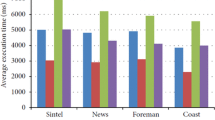Abstract
Ubiquitous network access implies that video can be streamed to portable devices whether they are moving outdoors or docked at home. Unfortunately, broadband wireless channels and their wired alternatives present a hostile environment for video communication, which manifests itself in error bursts. This paper presents a robust application layer, channel-coding scheme suitable for data-partitioned, compressed video. Data partitioning prioritizes the more important data within a compressed bitstream. In the scheme, the more important compressed data are protected prior to communication over an access network. In particular, window-growth rateless codes are used. This form of rateless code can be incrementally scaled to reflect the importance of the data being protected. The paper gives details of the scheme for achieving this in the context of an H.264/AVC codec’s picture types and structures. The paper considers how best to apply the scheme to H.264/AVC’s data-partitioning modes in a practical manner. Simulations of error-prone channels show that the proposed unequal protection scheme achieves several dBs of improvement in video quality, when compared with equal protection. The simulations modeled both wireless and wired access networks.






Similar content being viewed by others
Notes
An IDR picture is confusedly equivalent to an I-picture in previous standards. An I-picture in H.264/AVC allows predictive references beyond the boundary of a GoP.
Because of the cumulative effect of VLC, symbols nearer the slice synchronization marker suffer less from errors than those that appear later in a bitstream.
References
Afzal J, Stockhammer T, Gasiba T, Xu W (2006) Video streaming over MBMS: a system design approach. J Multimedia 1(5):25–35
Ahmad S, Hamzaoui R, Al-Akaidi M (2007) Robust live unicast video streaming with rateless codes. In: Proceedings of the 16th international packet video workshop, Lausanne, Switzerland, pp 78–84
Albanese A, Blömer J, Edmonds J, Luby M, Sudan M (1996) Priority encoding transmission. IEEE Trans Inf Theory 42(6):1737–1744
ANSI T1.413-1998 (1998) Network and customer installation interfaces—Asymmetric digital subscriber line (ADSL) Metallic interface. American National Standards Institute
Bouabdullah A, Lacan J (2006) Dependency aware unequal erasure protection codes. J Ziezhang Univ 7:27–33
Dhondt, Y, Mys, S, Vermeirsch, K, Van de Walle, R (2007) Constrained inter prediction: removing dependencies between different data partitions. In: Proceedings of advanced concepts for intelligent visual systems, pp 720–731
Fathi H, Chakroborty SS, Prasad R (2008) Models for performance analysis in wireless networks. Voice over IP in wireless heterogeneous networks signalling, mobility, and security. Springer, Berlin, pp 49–57
Ghanbari M (1997) Two-layer coding of video signals for VBR networks. IEEE J Sel Areas Commun 7(5):771–781
Ghanbari M (2003) Standard video codecs: image compression to advanced video coding. IET Publications, London
Klaue J, Rathke B, Wolisz A (2003) EvalVid—A framework for video transmission and quality evaluation. In: Proceedings of international conference on modeling techniques and tools for computer performance, pp 255–272
Kumar A (2007) Mobile TV: DVB-H, DMB, 3G systems and Rich media applications. Focal Press, Amsterdam
Lettieri P, Fragouli C, Srivastava MB (1997) Low power error control for wireless links. In: Proceedings of the 3rd annual ACM/IEEE international conference on mobile computing and networking, pp 139–150
Liang YJ, Apostolopoulos JG, Girod B (2008) Analysis of packet loss for compressed video: effect of burst losses and correlation between error frames. IEEE Trans Circuits Syst Video Technol 18(7):861–874
Luby M (2002) LT codes. In: Proceedings of the 34rd annual IEEE symposium on foundations of computer science, Vancouver, Canada, pp 271–280
Luby M, Stockhammer T, Watson M (2008) Application layer FEC in IPTV systems. IEEE Commun Mag 46(5):94–101
MacKay DJC (2005) Fountain codes. IEE Proc Commun 152(6):1062–1068
Palanki R, Yedidai J (2004) Rateless codes on noisy channels. In: Proceedings of interantional symposium information theory
Park S, Jeong S-H (2009) Mobile IPTV: approaches, challenges, standards and QoS support. IEEE Internet Comput 13(3):23–31
Peng C, Tan Y, Xiong N, Yang D, Zhang H, Chao H-C et al (2009) Adaptive video-on-demand broadcasting in ubiquitous computing environment. Springer J Pers Ubiquitous Comput 13(7):479–488
Rahnavard N, Vellambi BN, Fekri F (2007) Efficient broadcasting via rateless coding in multihop wireless networks with local information. In: Proceedings of the international wireless communications and mobile computing conference, Honolulu, Hawaii, pp 85–95
Rahnavard N, Vellambi BN, Fekri F (2007) Rateless codes with unequal error protection property. IEEE Trans Inf Theory 53(4):1521–1532
Reponen E, Huuskonen P, Mihalic K (2008) Primary and secondary context in mobile video communication. Springer J Pers Ubiquitous Comput 12(4):281–288
Robinson S, Eslambolchilar P, Jones M (2010) Exploring casual point-and-tilt interactions for mobile geo-blogging. Springer J Pers Ubiquitous Comput 14(4):363–379
Shokorallahi A (2006) Raptor codes. IEEE Trans Inf Theory 52(6):2551–2567
Stockhammer T, Bystrom M (2004) H.264/AVC data partitioning for mobile video communication. In: Proceedings of the international conference on image processing, Singapore, pp 545–548
Stockhammer T, Zia W (2007) Error-resilient coding and decoding strategies for video communication. In: Chou PA, van der Schaar M (eds) Multimedia in IP and wireless networks. Academic Press, Burlington, pp 13–58
Sullivan GJ, Wiegand T (2004) Video compression—from concepts to the H.264/AVC standard. Proc IEEE 93(1):18–31
Talari A, Rahnavard N (2009) Unequal error protection rateless coding for efficient MPEG video transmission. In: Proceedings of military communications conference, p 7
Vukobratovic D, Stankovic V, Sejdinovic D, Stankovic L, Ziong Z (2008) Expanding window Fountain codes for scalable video multicast. In: Proceedings of IEEE international conference on multimedia and expo, Hannover, Germany, pp 77–80
Wenger S (2003) H.264/AVC over IP. IEEE Trans Circuits Syst Video Technol 13:645–656
Zorzi M, Rao RR (1997) Error control and energy consumption in communications for nomadic computing. IEEE Trans Comput 46(2):279–289
Acknowledgments
The authors gratefully thank Rouzbeh Razavi and Muhammad Altaf for conducting simulations in support of the findings in this paper.
Author information
Authors and Affiliations
Corresponding author
Rights and permissions
About this article
Cite this article
Samek, H., Fleury, M. & Ghanbari, M. Robust video communication for ubiquitous network access. Pers Ubiquit Comput 15, 811–820 (2011). https://doi.org/10.1007/s00779-011-0367-3
Received:
Accepted:
Published:
Issue Date:
DOI: https://doi.org/10.1007/s00779-011-0367-3




